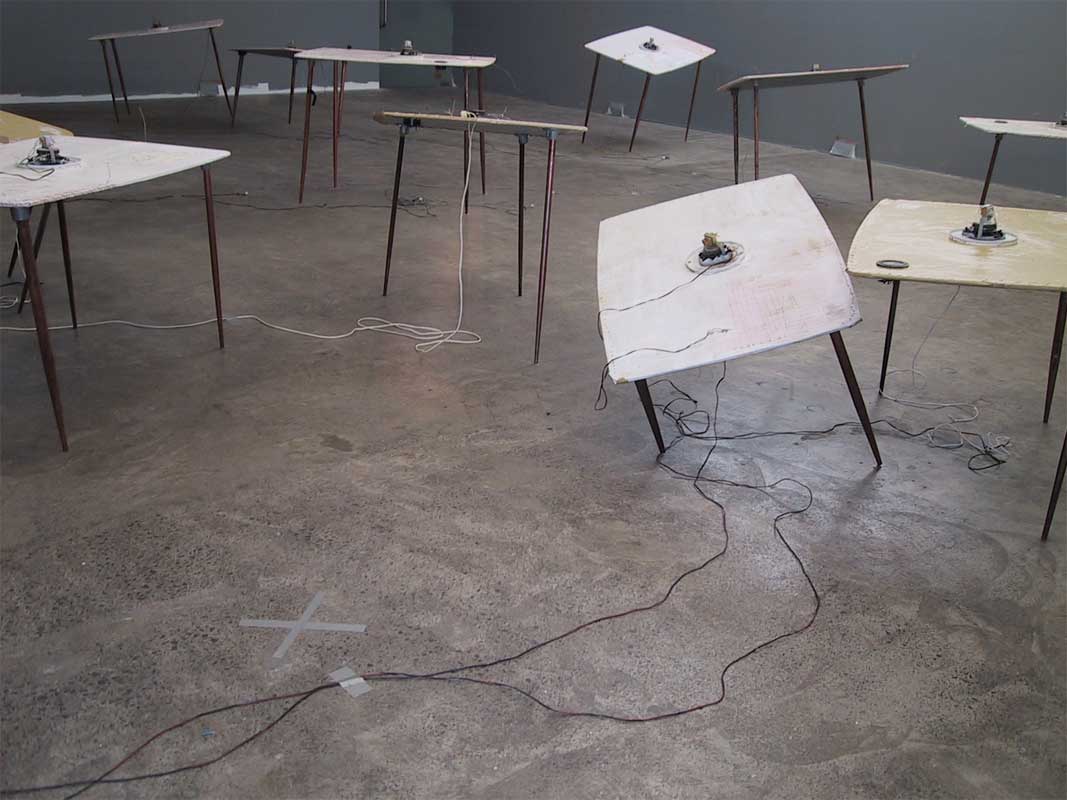Auckland Art Gallery News, November 2004–February 2005.
Et Al. are notorious for their mysterious installations using retrograde technologies. Simultaneous Invalidations, Second Attempt (2001) is typically obscure. A conclave of tables forms the heart of the work. With legs of different lengths, their tops are pitched at idiosyncratic ‘cubist’ angles. They are covered in domestic contact paper, laced with wires, and sport scientific-looking inscriptions and calculations. Some tables incorporate galvanometers, that register when you touch the wires on the tables’ edges. Speakers screwed face down into each tabletop emanate a hum, an electric crackle, which resonates through the tables. The sound swarms, darting from table to table, as if they were implicated in some communion ritual, some seance. If, at first, the sound is annoying, it soon comes to seem meditative, a balm; we tune in to it. The arrangement looks a science experiment—something borne out by the hypothesis-like title.
Jonathan Bywater suggests that Et Al.’s experiment may have a paranormal dimension. He wrote: ‘Possibly modelled here is early electronic research’s fascination with the occult; Thomas Edison was attempting to record the voices of the dead when he invented the phonograph; Nikola Tesla and Guglielmo Marconi envisaged radio as a means to communicate with the dead … These tables mock up levitation; the sound dances like a planchette over a Ouija board.’1 But, if this is the case, it is hard to know if the tables are wired up to amplify spirits or fake them.
To the side, a black-and-white video is projected, encompassing old archival footage of factory life, shots of a previous Et Al. installation (the ‘first attempt’?), and an ominous close up of a socked foot. In an adjacent space we find the CD player, amplifier, and antique laptop that run the machine, distributing sounds to the tables. It is part plant room, part surveillance station, part sick bay. A decrepit camp stretcher is positioned so the stretcher’s occupant can view a small video monitor hanging down from a galvanised pipe attached to the ceiling. But is it earmarked for us or the artist, for the prisoner, or the governor?
The work exudes an institutional air, but it’s hard to ascertain Et Al.’s relation to the institution. Are they behind it or critiquing it, running it or being run by it? Is the institution logical or demented, benevolent or diabolical? Simultaneous Invalidations, Second Attempt engages us through our own conflicted attitudes towards authority.
- Jonathan Bywater, ‘Simultaneous Invalidations’, Et Al.: Simultaneous Invalidations, Second Attempt (Auckland: Artspace, 2001), np.
